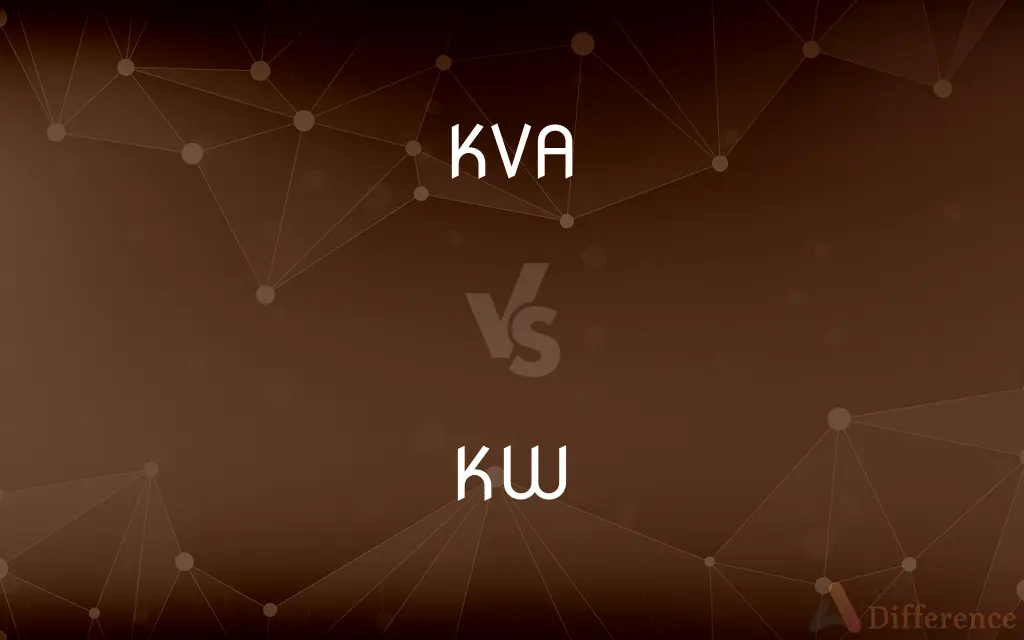KVA vs. KW — What's the Difference?
By Tayyaba Rehman — Published on January 4, 2024
KVA (Kilovolt-Ampere) is a unit of apparent power, representing the total power in an electrical circuit.KW (Kilowatt) is a unit of real power, representing the actual work done by electrical equipment.

Difference Between KVA and KW
Table of Contents
ADVERTISEMENT
Key Differences
KVA, or Kilovolt-Ampere, is a unit used in electrical engineering to measure apparent power. It considers both real power (KW) and reactive power (KVAR). Apparent power represents the total power flowing in an electrical circuit and is essential for sizing electrical equipment.
KW, or Kilowatt, is a unit of real power. It represents the actual work done by electrical equipment, such as motors, heaters, or lights. Real power is what performs useful work in an electrical system.
KVA is calculated as the vector sum of KW and KVAR, where KVAR is the reactive power. KW, on the other hand, is the product of voltage, current, and the power factor (cosine of the phase angle between voltage and current).
KVA is crucial for sizing transformers, generators, and other equipment to handle both real and reactive power, ensuring the efficient operation of electrical systems. KW is important for assessing the actual energy usage and billing purposes.
Comparison Chart
Definition
Apparent power (total power)
Real power (actual work done)
ADVERTISEMENT
Calculation
Vector sum of KW and KVAR
Voltage × Current × Power Factor
Importance
Sizing electrical equipment
Assessing energy usage
Compare with Definitions
KVA
Considers power factor.
Calculating KVA for power distribution.
KW
Measures useful energy.
Assessing KW for lighting systems.
KVA
Includes real and reactive power.
KVA is used for transformer sizing.
KW
KW is essential for appliances.
KW load analysis for homes.
KVA
Apparent power unit.
The UPS rating is 500 KVA.
KW
KW represents actual work.
The motor consumes 30 KW of power.
KVA
Needed for efficient equipment sizing.
Determining KVA requirements for factories.
KW
Indicates energy consumption.
KW rating for air conditioning.
KVA
KVA measures total power.
The generator has a capacity of 1000 KVA.
KW
Real power unit.
KW is used in electricity bills.
Common Curiosities
What is KVA in electricity?
KVA, or Kilovolt-Ampere, measures apparent power in an electrical circuit, including real and reactive power components.
Why is KVA important?
KVA is essential for sizing transformers, generators, and equipment to ensure efficient power delivery and prevent overloading.
What is the significance of KW?
KW is crucial for assessing energy usage, billing purposes, and determining the actual power requirements of devices.
What does a high KVA rating mean?
A high KVA rating indicates a greater capacity to handle both real and reactive power, suitable for larger electrical systems.
How are KVA and KW related?
KVA is the vector sum of KW and KVAR (reactive power). KW is a component of KVA that represents real power.
Where is KW commonly applied?
KW is applied in assessing energy consumption for various appliances, lighting, HVAC systems, and electricity billing.
What is the difference between KVA and KVAR?
KVAR represents reactive power, while KVA includes both real and reactive power components, including KVAR.
What is KW in electricity?
KW, or Kilowatt, represents real power, indicating the actual work performed by electrical equipment.
In what applications is KVA used?
KVA is used in sizing electrical equipment, such as transformers, generators, and UPS systems, for industrial and commercial applications.
What happens if KVA exceeds the equipment's rating?
Exceeding the equipment's KVA rating can lead to overheating, inefficiency, and damage to electrical devices.
How is KW calculated?
KW is calculated by multiplying the voltage, current, and power factor (cosine of the phase angle) in an electrical circuit.
What is the typical power factor value for efficient systems?
Efficient electrical systems aim for a power factor close to 1 (or 100%) to minimize reactive power and maximize real power utilization.
Can KW be greater than KVA?
No, KW cannot be greater than KVA; KW is always less than or equal to KVA.
What is the unit of power factor?
Power factor is a dimensionless quantity, expressed as a number between 0 and 1 or as a percentage.
How do power factor and KVA relate?
Power factor affects the ratio of KW to KVA; a lower power factor results in a higher KVA for the same KW.
Share Your Discovery

Previous Comparison
Hadoop vs. Hive
Next Comparison
US Thanksgiving vs. Canadian ThanksgivingAuthor Spotlight
Written by
Tayyaba RehmanTayyaba Rehman is a distinguished writer, currently serving as a primary contributor to askdifference.com. As a researcher in semantics and etymology, Tayyaba's passion for the complexity of languages and their distinctions has found a perfect home on the platform. Tayyaba delves into the intricacies of language, distinguishing between commonly confused words and phrases, thereby providing clarity for readers worldwide.














































